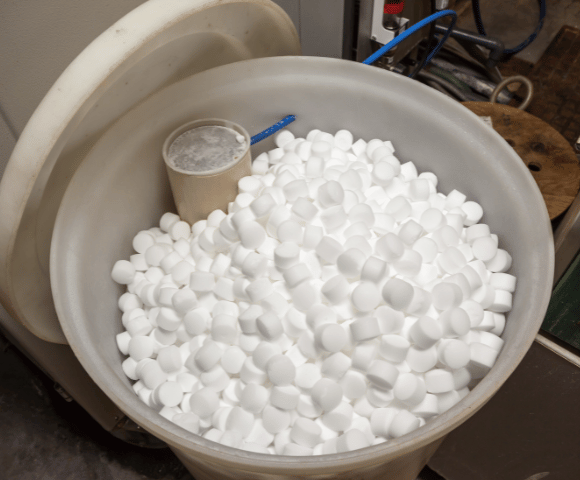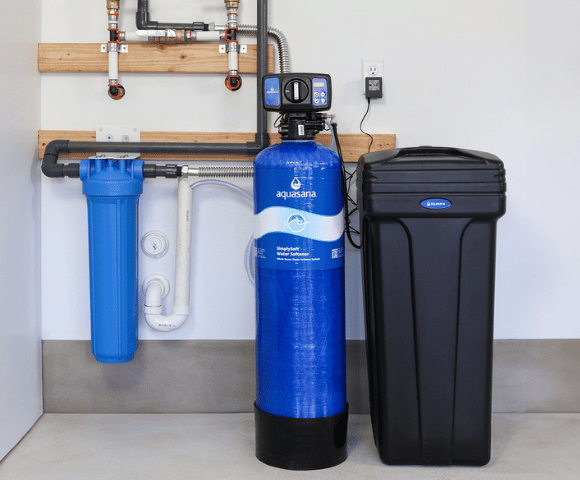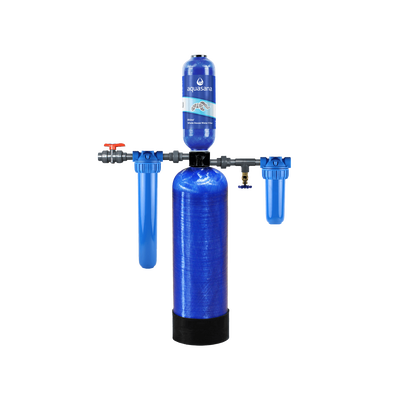1. Check salt levels
It’s important to check your salt levels regularly. Consult with your softener’s manual to know the ideal salt level, but in general, most brine tanks are best kept at least half-full. The salt level should always be above the brine water level. Keeping your brine tank half-full prevents undissolved salt from sticking to the walls and forming salt buildup, which reduces the effectiveness of your water softener.
On the other hand, your softener needs enough salt to create the brine solution so water can be softened. Even if you have a professional who comes to replace the salt for you, it’s still recommended to regularly check your salt levels to ensure your refill schedule meets your needs. Many systems feature warning systems that notify you when salt levels are running low. If you notice your salt levels running low before your next refill, you may want to consider reducing the amount of time between your refills.
If your system doesn’t feature an interface to display your salt level, you can still do it manually and it shouldn’t take more than a couple of minutes.
How to check salt levels

- Find your brine tank and remove the lid.
- Check where your salt pellet level is. There should be enough to cover any visible water.
- If you see water or the salt level is less than half the tank, refill the salt.
- If you notice crusting, use the handle of a broom to gently loosen up the salt on the side of the tank before refilling.
- Bonus step: Make a note of when you refilled your tank and track your refills so you can get a sense of how often you should refill your salt in the future.
2. Clean the brine tank
How often you need to clean your brine tank will depend on the type of water softener you have. For continued performance, brine tanks should be cleaned every 2-3 years.. The main reason most brine tanks need to be cleaned is because of the salt quality you use. Salts are classified based on the level of impurities they have. Salt with a high impurity count like block or solar salt can settle in your tank, creating salt sludge, and cause issues with the system.
Instead, consider using pellet salt which is the cleanest salt you can buy. Pellet salt has a low impurity level so it has a lower chance of causing buildup. It also can extend the length between brine tank cleanings.
If you do clean your brine tank, make sure your salt tank is nearly empty to make the process easier. As always, be sure to consult your manufacturer’s manual for cleaning instructions specific to your water softener.
How to clean the brine tank
- Find or prepare a place to dump the brine from the tank such as a pit or gravel bed in your yard.
- Turn on bypass mode.
- Unplug your system and disconnect the brine tank.
- Dump the brine from your brine tank in the place you identified in step 1.
- Once the brine is removed, disassemble your brine tank and valve and clean each part in cold water with dish detergent.
- Use a long handle brush to clean the inside of the tank.
- Use bleach and water solution (¼ cup of bleach to 1-3 gallons of water) and pour into the brine tank. Let it sit for 15 minutes then remove (keep the solution away from plants).
- Thoroughly scrub your brine tank one more time.
- Connect the valve back to the tank and reconnect to your system and water lines.
- Take the system out of bypass mode.
- Fill the tank with water (about 5 gallons).
- Fill with salt to the appropriate level (about halfway).
- Let salt sit in water for approximately 2 hours.
- Start the regeneration cycle.
3. Clear salt bridges and salt mushing
If you see salt buildup within your system in the form of salt bridges or salt mushing, you should clean your brine tank as soon as possible. A salt bridge occurs when a layer of hardened salt forms in your brine tank, creating a barrier between the salt and water, generally caused by humidity or poor quality salt. Salt bridges prevent salt in your softener from dissolving and creating the brine solution, which means your system won’t be able to soften hard water.
Salt mush is even worse and happens when dissolved salt recrystallizes. When salt recrystallizes, it can form slush on the bottom of your brine tank which puts your system at risk for a serious blockage and prevents your regeneration cycle from working properly. You can find out the difference between a salt bridge and salt mush by pushing on it with something long, like the handle of a broom. If it breaks apart then it’s a salt bridge, and if it doesn’t then you have salt mush. The only way to get rid of salt mush is to drain the softener and clean out the mush by hand.

To prevent this from happening, consider using high-purity salt pellets like evaporated salt. Also, be sure not to overfill your tank with salt. Too much salt can limit movement and cause old salt to stick to the walls of the brine tank. Finally, take extra caution if your softener is in an environment with high humidity because there’s a greater chance of condensation in the brine tank which contributes to salt bridges and mush.
How to clear salt bridges and salt mushing
- Use a rubber mallet to pound on the outside of the brine tank or pour a small amount of warm water around the inside edges of the brine tank to break up the bridging.
- Allow 4 hours to produce a brine solution, then manually regenerate the system.
- Allow the system to use up any remaining salt and then thoroughly clean out the brine tank.
- If you are struggling to break up the salt you can try using a tool with a long handle like a broom.
4. Flush out minerals from resin beads
Resin beads might need to be flushed every few months with a water softener cleaner to keep them working efficiently. Resin beads are exposed to minerals such as iron, heavy metals, and other natural compounds which can build up over time. Although the regeneration cycle helps to remove most minerals, some can remain attached to the resin beads. If the resin beads are over-exposed to too many minerals, this can affect their efficiency and the quality of your water.
To flush away these minerals, you can purchase a water softener cleaner. Simply pour the cleaner into your brine well, a smaller component in your brine tank, and manually perform a regeneration cycle. The cleaner will flush the remaining minerals from your resin beads, which will help extend the life and increase the efficiency of your beads.
How to clean resin beads
- Purchase a water softener cleaner.
- Locate the brine well in your brine tank (usually a cylindrical barrier or tube).
- Pour the amount recommended by your manufacturer into the brine well.
- Perform a regeneration cycle.
5. Adjust the bypass valve
The bypass valve is a rod used to control the water flow, and it’s a good idea to adjust it regularly to make sure it doesn’t become stiff or stuck from a lack of use. Try to adjust the valve at least once a month or if you notice any stiffness.
How to adjust the bypass valve
- Locate your bypass valve (usually near the water pipes that connect to the unit).
- Turn the bypass valve inwards to temporarily block the water flow.
- Twist the intake and outtake valves to the off position.
- Return the intake and outtake valves to their original position.
- Turn the bypass valves back on.
- If any valves leak during this process, disassemble and replace any washers or seals connected to those valves.
Extend the performance and lifespan of your water softener
At Aquasana, we specialize in helping homeowners improve the quality of their water by removing contaminants and tackling issues like hard water. Our water softeners are highly effective and easy to maintain, and they even come with a low-maintenance pre-filter to further protect the system against dirt, rust, and other sediment that can clog your system.
If you already have a softener from another brand, we offer a universal water softener cleaner that can enhance the performance and extend the lifespan of your system. The cleaner targets contaminants like iron and scale buildup that can build on resin beads, valves, and other places in your system. Each bottle contains two doses, and we recommend using it every 3-4 months to keep your softener performing at its peak.
WHOLE HOUSE WATER SOFTENER
SimplySoft® 40,000 Grain Softener
Reduces minerals that cause hard water, providing softer, scale-free water from every tap in your home.
.png)


